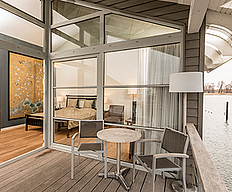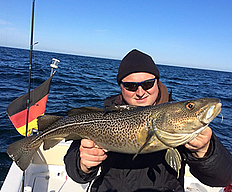An ice sled may look harmless. Three skids, one sail and a few ropes. And on the seat a driver packed up comically in a sort of sleeping bag. That’s Robby, employee of the “Wasserferienwelt im-jaich” in Lauterbach. He’s wearing a helmet, eyes protected by glasses, his shoes have spikes and his hands are covered by thick mittens. Two ice picks are hung around his neck. You might already think about him as “Racing Robby” if you see him in summer, shooting across the bay in his catamaran. But here, on the sheer expanse of frozen ice of the “Puddeminer Wiek”, he seems more like a “Racing Roland”. Because the little, chugging train in Rügen of the same name looks more like a “Trabi” next to Robby’s racing sled.

Anyway, when he starts out, Robby aligns the sails, releases the brakes and - where is he now? In 0,0 seconds his sled shoots off like a rocket towards the horizon and would probably disappear there if the bay wouldn’t have a shore at the other side. But now, the sled is turned to the right as fast as lightning - Robby is scratching across the ice, the sound of the skids on ice can be heard from far off. In a risky, almost 180º turn he manoeuvres around other sailors, glides past a reed island, disappears for a second behind the reeds and appears to be gone. Wait, no, there he is, his sled is slower now, the panicked seagulls landing, annoyed, within a safe distance. But then the “motor”, the wind, starts up again, and not a second later Robby is racing across the ice again like an arrow through the air. Just watching him can make anyone feel intoxicated by the speed.

After a few minutes Robby approaches again, pulling the brake. Smoke, no, ice crystals fly into the sky, the sled comes to a stop. And Robby looks so happy as if he just saw his idol, Sebastian Vettel.
The comparison to Formula 1 isn’t even that far off. An ice sled belongs to Formula Ice, not much slower than the racing four-wheelers, but much more environmentally friendly: no noise, no smell of gasoline, no bulldozers needed to make the racing stretch, causing locals to start protests. But no lightly dressed girls are there to cheer anyone on - unless of course they are very hardened. And if the wind dies down, nothing can help the racers to start up again - but at least the bad luck hits all contestants.
Other than that, racing on the ice is just as breathtaking as the effective public traffic circle at the Nürburgring. And sometimes just as dangerous - if one happens to break through the ice without the necessary ice picks to pull oneself out again. Or if one doesn’t know how to brake using spikes. Or if one crashes into a swan. Or if one… “Or if one stands around too long”, Robby says and invites me into the sled.

If I had to paint a picture of the next few minutes, it would look like a blurred watercolor. Nothing is clear anymore, everything rushes past me: the reeds, the shore, the trees, the houses behind the fields, it all turns into a colourful blur, in the middle, a little bit of black - that was when I lost consciousness. If I could have written, my notes would have read: “AHHHH!”, “Nooo!”, “Oh my God!” and maybe the question: “How high are we flying?”.
And that, even though the history of ice sailing started so comfortably. That was in Holland in the 17th century and the sleds were still boats with skids attached to the bottom. That way, small loads could be transported easily over lakes and rivers in Winter. Ice sleds are also known in Mongolia, where they were used for fishing. But soon, a racing sport scene was established, but since the competition wasn’t big enough, they competed against trains. Back then, steam trains were still in use, but even now ice sleds wouldn’t look bad next to modern trains. The alleged speed record in 230 km per hour. This record was set in 1938 on the US Lake Winnebago. The wind supposedly reached hurricane force, but stiff winds are already enough to reach the normal 100 km per hour. Kiters use these winds too nowadays, holding kites while ice skating, as well as surfers with boards built with special rigging. However, they still can’t keep up with ice sleds.
Because they are hardly braked by annoying friction and can even be faster than the wind, which they need as a motor. They can actually overtake the wind! That’s like a car driving away from his own gas tank. “That happens when we tack”, Robby the sailing teacher says and then explains the phenomena. However, I must admit that I no longer could keep up, because I was so dizzy from my dance with the “ice Porsche”.
By now there are different boat types, with sizes up to those of normal yachts, with the most common being the DN-class, also known as “beach sails”. This category uses a standard introduced by the newspaper “Detroit News”, which requires a sail area of 6,5 m2 and a length of 2,6 metres. Some people make their own sleds, desert princes own jewel studded sleds, there are regional, European and international championships, there are adored champions who have been compared to Michael Schumacher and of course there are also expensive equipment companies who offer everything from spikes (to brake safely) to large sails for catching the wind. All that’s missing now is the ice lake with built-in frost makers because ice sailors still rely on the cold season to fly across the ice. Cooled skids might also be helpful, I think as I watch Robby racing across the Puddeminer Wiek again. The heat of his skids might just make the ice under him melt. It crashes loudly once, maybe that was the jet high over the water.

Spend your vacation 2,4 meters over the water in our exclusive Maldivian-style Stilt House Suites

We serve regional cuisine prepared with fresh, seasonal ingredients in our restaurant at the “Wasserferienwelt"

From Sailing Courses to Stand Up paddling: many aquatic sports are waiting for you on Rügen


